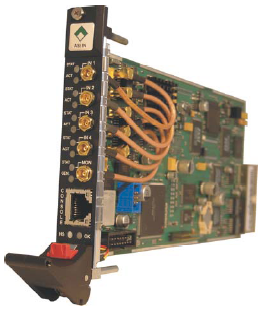|
|

Falcon Quad DVB-ASI Input Card
4개의 ASI MPEG stream (SPTS or MPTS)신호를 입력받아 2개의 Network Interface모듈과 연결하는 장비
ATM 신호 ASI신호에 문제 발생시 자동 스위칭 기능
RS-232 컨트롤 Features
• 4x ASI Input
• Configurable redundant DVB-ASI input
• Configurable integrated ASI A-B switch (2 input pairs)
• DVB-ASI monitoring output
• Byte- and Packet mode
• 188- and 204 Byte TS-Packet size
• MPEG Reed-Solomon error detection
• SPTS and MPTS
• TS rates from 1.5 to 160 Mbps
• AAL1 and AAL1-FEC support
• Full VPI/VCI range
• Traffic Shaping
• Redundant ATM output
• Local CPU
• Local storage of configuration parameters
• Hot-Swap and Hot-Plug
Application
The DVB-ASI input card converts up to 4 MPEG stream (SPTS or MPTS) with a constant TS
rate from 1.5Mbps up to 160Mbps to an ATM cell stream, either using AAL1 (ATM
Adaptation Layer 1, with or without FEC). For protection switching on ASI level the card can
be configured in such a way, that a pair of inputs are used with an A-B switch. An automatic
and seamless protection switching will be performed in case of LOS (Loss of Signal) on ATM
side or a loss of the MPEG TS input signals.
The card supports ASI burst and packet mode as well as TS packet sizes of 188 and 204
Byte. In case of 204 Byte packets an error detection of the TS packet can be performed
based on the integrated Reed-Solomon (RS) processor. The MPEG RS can be stripped off
or transported transparently.
According to the user configuration the MPEG TS packets are mapped to AAL1 without or
AAL1 with FEC (ITU-T I.361.1). The resulting ATM cell stream is shaped by the use of an
extended Dual-Leaky-Bucket algorithm to assure an equidistant cell distribution. Each ATM
traffic can be sent over 2 high-speed serial links supporting redundant network interfaces
and protection switching on ATM level.
The card can be configured by using the console port (RS232) or in combination with an
installed controller card via the 2 redundant Ethernet ports. All configuration parameters are
stored locally and non-volatile. The entire function of the module is controlled by the onboard
CPU. The firmware is stored in the on-board Flash memory.
The card supports hot-plug and hot-swap according to the Compact-PCI specification.
|

|
|